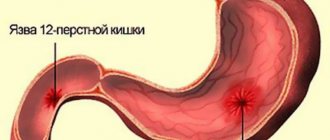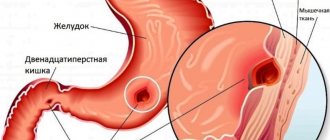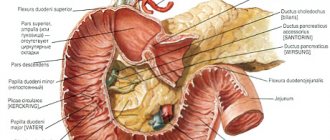Description and types
Tumors in the duodenum are benign neoplasms that are localized on the wall of the body of the organ or its bulb with growth into the lumen. They are formed from the glandular epithelium of the intestinal wall, can have a thin stalk, or can be supported on a wide base. Polyps can be single, multiple, or polyposis.
Polyps have a tendency to malignancy, that is, malignancy, so their presence is considered a precancerous condition. The risk of malignancy is higher with a hereditary form of polyposis. Therefore, if tumors are detected in the duodenum, their surgical removal is recommended. A feature of the disease is the difficulty of diagnosis due to a blurred clinical picture or its absence, especially with small formations.
Externally, polypous tumors look different. In addition to the base, they differ in shape: spherical, oval, mushroom-shaped. The surface of the formations can be velvety, smooth, bumpy, granular. Villous polyps look like cauliflower. The tumor has a darker shade than the mucous membrane itself. The color saturation of the formation depends on the structure and number of vessels with fibrin in it.
Still, the main danger of polyps is the likelihood of them becoming cancerous.
The polypous body is formed from the glandular or integumentary parts of the epithelium. The connective tissue of the polyp contains a dense network of vessels. The stalk of the formation is formed from the adjacent mucosa and submucosal layer.
Polypous tumors can be:
- small – with a size of up to 20 mm;
- large - with a size of 20-50 mm;
- gigantic - over 50 mm.
Types of polyps:
- inflammatory, which formed in places of tissue inflammation;
- hyperplastic, formed from overgrown normal tissue;
- neoplastic, when growth came from tissues and cells atypical for the organ.
Neoplastic polyps are:
- benign;
- malignant or adenomatous, which according to their structure are divided into tubular, tubular-villous, villous adenomas (similar to cauliflower).
Causes of polyp in the duodenum
Poor ecology, heredity, and bad habits are common causes of neoplasms on the walls of the duodenum.
There is no clear list of reasons that cause the formation of polyps in the duodenum. Doctors have identified a number of predisposing factors, such as:
- heredity, when in the anamnesis there are cases of diagnosis of neoplasms in relatives;
- bad habits (smoking, alcohol abuse);
- unbalanced, unhealthy diet (exceeding the norm of consumption of over-salted, smoked, fatty, heavy foods with a lack of vegetables and fruits);
- poor environmental conditions;
- decreased immunity;
- chronic inflammatory diseases of the duodenum, digestive system and blood vessels;
- allergic reactions, for example to gluten.
Causes
It is impossible to clearly name the cause of the appearance of duodenal polyps, however, through various studies, factors have been identified that can lead to this pathology:
- Duodenal ulcer. In this case, polyps form at the site of ulceration;
- Polyposis of the stomach or colon, when formations spread from nearby organs;
- Hereditary predisposition. If there are cases of polyposis or intestinal cancer in the family history, this increases the possibility of occurrence in blood relatives;
- Nutrition, if the regimen, method, products harm the digestive tract;
- Bad habits significantly reduce the chances of gastrointestinal health;
- Unwise approach to taking medications with irritating properties;
- A sedentary lifestyle contributes to congestion and poor peristalsis;
- Inflammatory processes and infections;
- Pathologies of the gallbladder and pancreas lead to irritation of the mucous membrane due to the release of concentrated bile through the duct;
- Increased acidity in the stomach disrupts the acid-base balance of the duodenum, leading to inflammatory processes.
Symptoms
Features of the clinical picture of duodenal disease are the asymptomatic nature of the first stages, the slow development and growth of the polyps themselves compared to lesions of other organs.
Alarming symptoms are:
Prolonged abdominal pain, sudden weight loss, nausea and vomiting are “companions” of duodenal polyps.
- nagging pain in the epigastric region or spread throughout the abdomen (occurs 1-3 hours after finishing a meal);
- belching of food or air (less frequently);
- heartburn, chest burning;
- general weakness, malaise, dizziness, which indicate hidden bleeding;
- a sharp drop in body weight;
- loose stools, diarrhea followed by constipation;
- nausea and vomiting;
- anemia and iron deficiency.
The severity and intensity of the clinical picture depends on the type and size of the tumor, the presence/absence of ulceration of the formation itself or the duodenal mucosa.
Nature of the disease
There are many theories about the nature of the appearance of these formations. Scientists identify three main ones:
- Theory of irritation. The essence of the theory is that a polyp is a transitional link between the inflammatory process in the mucous membrane and a malignant neoplasm.
- Disregenerative theory. The point is that, due to the constant inflammatory process in the mucous membrane, a cascade of regenerative reactions is triggered, which leads to the formation of excess tissue.
- The theory of embryonic dystopia. The essence of the theory is that polyps are formed as a result of improper embryonic anlage of the intestinal mucosa.
The most common causes of duodenal polyps include:
- Hereditary factor. There is a high risk of developing pathology if parents and close relatives have one.
- Unfavorable environmental conditions or working conditions.
- Low physical activity.
- Poor nutrition. Excess of fatty, fried, salty and smoked foods in the diet.
- Intestinal dysbiosis. Violation of the composition of its microflora and frequent constipation.
- Taking medications that provoke an inflammatory process in the intestinal mucosa.
- Frequent drinking of alcoholic beverages, smoking.
- Chronic diseases of the stomach and duodenum with frequent relapses.
Diagnostics
Due to the asymptomatic nature of the disease, detection of a polyp is difficult. A thorough examination of the patient is required to make an accurate diagnosis. For this purpose the following studies are carried out:
- Assessment of medical history, family history, and patient complaints.
- Objective examination (skin, mucous membranes, determination of body weight).
- Laboratory tests:
- blood test (for signs of anemia);
- coprogram, including stool analysis for occult blood.
If polyposis in the duodenum is suspected, the patient undergoes tests, undergoes a hardware examination and consults with doctors as directed.
- Instrumental diagnostics, including:
- FEGDS;
- radiography with contrast;
- Ultrasound;
- CT, MRI;
- probing.
- Examinations by a gastroenterologist, oncologist, therapist.
Prevention
There are no specific preventive recommendations against the formation of tumors; people just need to follow a few rules:
- lead a healthy lifestyle;
- watch your diet;
- promptly eliminate those diseases that can cause duodenal cancer;
- Several times a year he undergoes preventive examination by a gastroenterologist.
The prognosis of tumors directly depends on the nature of the neoplasm, the stage of development of the disease and timely initiation of therapy.
FEGDS
Fibroesophagogastroduodenoscopy is the most revealing diagnostic method. It is used for visual inspection of the condition of the mucous membrane of the duodenum and the gastrointestinal tract as a whole. This is done using a special instrument - an endoscope, equipped with a camera, optics and devices for collecting biological material for histological, cytological and morphological analysis. A biopsy is performed to assess the structure of damaged tissue and the degree of benign or malignant polyp. All casino bonuses are collected here. The only contraindication to the use of a biopsy is a blood clotting disorder. If a polyp is found, it can be removed immediately using a special metal loop.
ethnoscience
Despite the previous warnings, there are cases of complete recovery from polyps using non-traditional treatment methods. The basis of such funds includes:
- Celandine;
- Honey;
- Viburnum berries;
- Propolis;
- Mumiyo;
- Olive oil;
- Infusions and decoctions of herbs.
It is worth saying that each case is unique and requires an individual, competent approach. Doctors recommend for those who want to try traditional recipes:
- Follow the dosage.
- Monitor the condition.
- Do not refuse drug treatment.
- Find out contraindications to the ingredients of the drug.
- Follow the diet prescribed for all gastroenterologist patients.
- Before starting the course, consult with a representative of official medicine.
Probing
The procedure allows you to determine the degree of secretory activity by analyzing the contents of the duodenum. There are several methods for carrying out the liquid material selection procedure, such as:
- blind tubage - forced emptying of an organ followed by an ultrasound examination;
- fractional duodenal intubation - sampling of material every 5 minutes to assess the overall functional activity of the organ;
- chromatic using methylene blue dye - to assess patency and contractile function.
CT
The method is classified as additional or auxiliary. Benefits of the procedure:
- the ability to identify small polyps;
- non-invasive;
- lack of special training;
- determination of the structure, location of the polyp, as well as accompanying anomalies of the gastrointestinal tract;
- assessment of contrast accumulation by polyps;
- identifying the cause of polyp formation.
The only drawback is the high cost. CT is indicated if malignancy is suspected or it is impossible to perform FGDS.
MRI
The method allows you to obtain a 3D picture of the duodenum. Before the procedure, you should cleanse the intestines with an enema. The method is rarely used due to the multi-layered nature of the intestine and the difficulty of examining all its bends.
Advantages of the method:
- the ability to determine the degree of parietal and transmural damage;
- detection of small tumors and fistulas.
Flaws:
- ineffectiveness in detecting inflammatory processes, especially on mucous membranes;
- high price.
Treatment and removal
Doctors recommend treating tumors only surgically, so after making a diagnosis and determining the characteristics of the tumor, a decision is made on the technique for removing it.
After surgery, growths in the duodenum are additionally treated with antiflatulents and antispasmodics.
Less commonly, a course of medication may be prescribed to prepare and restore the patient’s strength before surgery, which is important in cases of weakened immunity, bleeding disorders, anemia, and in old age.
The following medications are usually prescribed:
- "Simethicone" and other representatives of the group of antiflatulents for bloating;
- “No-spa” and similar antispasmodics for severe pain.
The choice of surgical technique depends on the following indicators:
- size;
- localization (if the bulb is affected, abdominal surgery is chosen);
- quantity;
- shape of polyps.
Clinical symptoms
Quite often, the presence of polyps in the duodenum does not manifest itself clinically. This is due to their slow growth and small size in the early stages of the disease.
Usually this benign tumor is found by chance during a medical examination, but sometimes (with a large size of the tumor, dysfunction of neighboring organs, disruption of the integrity of the intestinal wall) clinical symptoms can be pronounced.
Clinical symptoms of duodenal polyps include:
- Nagging pain or discomfort in the upper abdomen.
- Heartburn and belching.
- Dyspeptic disorders (nausea, vomiting, constipation or diarrhea).
- Loss of appetite, weight loss against this background in a short time.
- Weakness and dizziness (if hidden bleeding occurs).
- Neurotic disorders (depressive states).
Duodenoscopy
The diagnostic procedure allows for the immediate removal of polyps up to 20 mm in size on a stalk with an oval head immediately during diagnosis. To do this, a gastroduodenoscope with fiber-optic equipment and a metal loop to capture the polyp is inserted into the patient through the esophagus. Additionally, cauterization of bleeding wounds after cutting off the tumor (coagulation), laser therapy and medicinal sanitation are carried out. The main advantages of the method are painlessness and minimally invasiveness.
Abdominal surgery
Large polyps up to 50 mm in size, more or less small polyps located in the duodenal bulb, are removed in the classical way - resection of the affected area.
Extensive polyposis in the duodenum is eliminated by surgery.
Operation stages:
- opening of the peritoneum;
- organ exposure;
- wall dissection;
- polyp removal.
During the operation, duodenal tissue is additionally analyzed for histology. If the malignant nature is confirmed, treatment will be not only surgical, but also chemotherapy or radiation.
Treatment of intestinal polyps
Treatment of intestinal polyps is only surgical. Since only an assumption about the nature of the polyp can be made before histological examination, as a rule, it is removed during endoscopy. If there are many polyps, endoscopic removal is performed in several stages.
In the case of familial adenomatosis, when the number of neoplasms exceeds several thousand and they cover the mucosa almost completely, resection (removal) of part of the colon or the entire colon is performed, depending on the volume of the lesion.
Large polyps that cannot be removed endoscopically are eliminated surgically.
Gastroprotectors (rebamipide) are recommended as drug therapy. They promote healing of the gastrointestinal mucosa and reduce inflammatory activity.
Complications
With a benign tumor, the prognosis is always favorable, but the risk of relapse remains. Therefore, patients are monitored at the dispensary. There is always a risk of complications of the disease in the form of:
- malignancy into metastatic cancer;
- tumor perforation with the risk of hole formation in the wall of the duodenum and the development of severe inflammation of the peritoneum (peritonitis);
- stenosis, which involves a narrowing of the intestinal lumen, which is likely when the polyp increases to gigantic size;
- ulceration of the surface of the formation;
- bleeding from the polyp.











